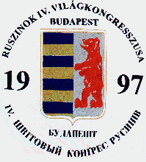|
 The Rusyns
The Rusyns
of Hungary
End of the
millennial struggle
Brian Požun
Never could it be said that the Rusyns and Hungarians are strangers to one another. From the very beginning of Magyar statehood over one thousand years ago, the two nations have existed side by side. The very fact that the East Slavs, who became the Rusyns, found themselves under Magyar rule for an entire millennium is the crux of the Rusyns' claim to the status of the fourth East Slavic nation; related to, but separate from, the Russians, Ukrainians and Belarusians.
While the history of the treatment of Rusyns by the Magyars is not necessarily something that can be held up as a shining example of majority-minority relations, the current policies in force in Hungary certainly can. Now that the Rusyn community in Hungary is counted in the hundreds and not in the hundreds of thousands (as it was before the First World War), Budapest has finally given the Rusyns what they had demanded for a millennium: a degree of autonomy.
Hungary and its minorities
The Rusyns may very well be the oldest minority group in Hungary, but they are by no means the only one or anything close to the largest. The country is currently home to thirteen groups recognized as national minorities. Armenians, Bulgarians, Croats, Germans, Greeks, Gypsies, Poles, Romanians, Serbs, Slovaks, Slovenes and Ukrainians all join the Rusyns in what could be a zoo with most all of the nations of Central Europe—and several more exotic species—on display.
The 1990 census counted Rusyns together with Ukrainians, following standard Eastern-Bloc practice, and found only 674 people speaking either Rusyn or Ukrainian as their mother tongue. Today, Budapest's official estimates say there are 1000 Rusyns in Hungary (separate from Ukrainians), while Rusyn organizations claim the figure is as high as 6000.
Rusyns no longer make much of an impact on Hungarian society. The Rusyn language is used as a significant mode of communication in just two villages, both in Borsod-Abaúj-Zemplén county in the north-east. One the Rusyns call Mucon (Múcsony) and the other Komloška (Komlóska).
The Rusyn movement in Hungary has made significant progress since taking its first steps in 1991 with the formation of the Organization of Rusyns in Hungary. Several cultural institutions have been created, among them the Andy Warhol Arts Association (1995), the Rusyn Research Institute (1996) and the Rusyn Museum in Múcsony (1998).
 Beginning with the 1995/6 school year, eighteen grade schoolers in Múcsony had the opportunity to study in the Rusyn language, and the following year enrollment jumped to 68.
The Rusyn language is also promoted in the media. The community has two primary publications, Ruszinszkij Zsivot/Rusinskyj Život (Rusyn Life), and Országos Ruszin Hírlap/Vsederžavnyj Rusynskyj Visnyk (National Rusyn Newsbulletin). Starting in 1996, channel 1 of Hungarian television began broadcasting a monthly program in Rusyn, and from October of 1997, it has broadcast a weekly Rusyn-language program on channel 2.
Capping off the achievements, Budapest hosted the fourth World Congress of Rusyns in 1997. The Congress, held biennially, is the central event of the international Rusyn community. Representatives of Rusyn organizations from throughout Central Europe and abroad attended the three-day event, and all were impressed with the hospitality showed by the Hungarian capital.
Diversity, real or imagined
Hungary is a highly diverse country, though the sheer number of national groups gives a false impression of this diversity. The thirteen groups that have been granted full national minority protection, however, account for little more than one percent of the total population of Hungary.
Their situation is precarious, given the fact that 40 to 60 percent of adult members of minority groups live in ethnically-mixed marriages, which increases the rate of assimilation into the majority population. International observers believe that minority populations (with the notable exception of the Roma) are fully integrated into Magyar society, a fact which attests to both the reasonable policies of Budapest and to the increasing rates of assimilation.
Out of the goodness of their hearts?
By all accounts, Hungary has instituted what may be the most liberal minority policies in Europe, covering almost all of its non-Magyar residents. The most striking aspect of the policies is the system of minority self-governments throughout the country. International observers has hailed the unique experiment as a significant step forward for minority rights worldwide, even though it is not without its flaws.
The basic document delineating minority rights in Hungary is Article 68 of the Constitution, which grants minorities the rights to collective participation in public life; to use their own languages; to receive schooling in their own languages; and to establish local and national self-governments. A 96-percent majority passed the Act on the Rights of National and Ethnic Minorities in 1993, extending minority rights to have not only a collective but also an individual nature.
In 1996, a Commissioner for the Rights of National and Ethnic Minorities was elected by parliament to act as an ombudsman for minority rights. Also in 1996, legislation was passed which introduced the concept of hate-crimes against national minorities.
All this, however, was not done because Budapest has suddenly taken a liking to its domestic minorities. The overriding motivation was that such large numbers of Magyars live outside the borders of today's Hungary: in Slovakia, Ukraine, Yugoslavia and elsewhere. The general belief is that if Budapest provides its minorities with the highest levels of protection, then it has the right to demand the same levels of protection for Magyar minorities abroad. Even so, the motivation should not belittle the accomplishment.
Self-governance—a bold experiment
The system of self-governance Budapest has established for its minorities is unique in Europe, if not worldwide. In settlements with a significant number of inhabitants belonging to a minority, that minority is permitted by the constitution to establish a local self-government structure with several minority-specific mandates. The members of the self-government are chosen in popular elections.
Additionally, each of the minorities with local self-governments is entitled to form a national self-government in the capital. The members of the national bodies are elected by the members of the local ones. Though it has not happened as of yet, a group of local self-governments could, theoretically, form a regional tier of minority autonomy. The members of the national bodies are elected by the members of the local ones. Though it has not happened as of yet, a group of local self-governments could, theoretically, form a regional tier of minority autonomy.
The basic mandate of a local self-government is to promote the national culture of the minority. It also has the right to consult with local authorities on matters concerning the minority, such as in the fields of public education, culture, media and use of languages.
The national self-governments work in tandem with the national government in the same way. They promote the minority's culture on the national level, and have the right to register content or disapproval with national decisions in similar fields.
Nothing is perfect
Even though the minority self-government system represents one of the highest levels of minority involvement in governance anywhere in Europe, it is faced with several problems that must be resolved quickly in order for the system to function smoothly.
The biggest problem with the system is no surprise: lack of funding. The government must provide each local and national minority self-government with both appropriate facilities to act as a central office and funding according to legislation as well as allocations from the national budget. Unfortunately, the resources made available to the self-governments are, most times, not even close to fulfilling their requirements, and too often programs planned by the self-governments must be scaled back or canceled altogether for lack of funding.
Another concern is the method of electing representatives to the self-governments. As it stands, the elections to self-governments are open to all voters in the country, regardless of whether they actually belong to the minority involved.
Several options have been explored to devise a solution, but none have proved acceptable thus far. The idea of registering members of national minorities was quickly shelved, after it conjured up nightmares of Nazi-era policies. Another suggestion was to have the elections to minority self-governments on a different day from general elections, with the thought that only members of the minority would be inclined to make the effort to vote.
Self-government: the Rusyn experience
The system of minority self-governments came into force when elections to these bodies were held in tandem with the local elections of 1994 throughout Hungary. By the 1998 elections, 1363 local self-government organizations were established, 48 of which actually replaced their municipal administrations and assumed all of their duties. By February 1999, twelve of the thirteen eligible groups had also established a self-government at the national level.
In 1994, the Rusyns founded their first local self-government in Múcsony, and currently there is a total of ten all together. Aside from three in Borsod-Abaúj-Zemplén county, where the majority of Rusyns live in Hungary, there are also five in various districts of Budapest and another in the municipality of Pest.
The tenth is the national self-government based in Budapest. Rusyns formed the national self-government in October 1998, when local Rusyn self-governments elected the five members of the nation administration. National self-governments are headed jointly by a president and attachés for environmental, media and cultural issues.
After the first elections to national self-governments, the XII district of Budapest was home to just four, serving the German, Croat, Slovene and Armenian communities. With the 1998 elections, four more were created, to serve the Roma, Serb, Greek and Rusyn communities.
While this represented a significant step forward in minority representation in the capital, it came at a price: the district's budget was stretched to the breaking point and it was decided that none of the members of the national self-governments in the XII district would receive the honoraria they had received in the past. For now, this is the only such district in Budapest, but the pattern could easily be repeated elsewhere.
Even though the Rusyns had the bad luck of founding their national self-government in the district with the tightest budget, the self-government has undertaken several important initiatives in the past three years. They have organized dozens of important cultural events and have their own website. They are also working closely with other parts of the Rusyn community.
One of their partners is the Organization of Rusyn Youth, which has set for itself the mission of promoting a Rusyn and European identity among young people, helping them to better themselves; working to help the poor and disadvantaged; preventing drug, alcohol and tobacco use among Rusyn children.
Another major partner is the Rusyn Research Institute in Budapest. With the Institute, the self-government has organized several series of lectures and biannual international conferences of Rusyn studies. Themes from the past two years include "1100 Years of Peaceful Rusyn-Magyar Coexistence: An Example for the Nations of Central Europe" and "The Rusophile Trend in the Rusyn National Renaissance."
The national self-government also promotes the use of the Rusyn language in media. Together with its support and that of the national Foundation for National and Ethnic Minorities, the bilingual black-and-white monthly newsbulletin of the capital was able to introduce a color cover in March 2000, and is now called the Országos Ruszin Hírlap/Vsederžavnyj Rusynskyj Visnyk (National Rusyn Newsbulletin).
In the final analysis...
Since its inception in 1994, Hungary's system of minority self-governments has represented one of the most important steps forward in protection of national minorities to be found anywhere in Europe, if not the world. Given that the thirteen national minorities are an insignificant proportion of the Hungarian population, that it has taken place in Hungary is curious, but also quite important. Due to their small size, the minority populations in Hungary face an even greater threat of assimilation and extinction than more sizable groups elsewhere.
It is impossible to say that the self-governments and Hungarian minority policy have created a utopia for minorities. The self-governments have limited mandates and serve only an advisory role, there is a constant lack of funds for them and their elections are open to all voters. And the government's very motivation for pursuing a liberal minority policy is not necessarily pure of heart. Even still, the self-governments go a long way towards securing the place of minorities in society.
The Rusyns of Hungary are among the luckiest of Rusyn communities elsewhere in Europe. Numerically, they are paltry compared to Rusyn communities in Ukraine or Slovakia, but their situation is significantly better. This fact represents a major historical turnaround. For more than a millennium, the majority of Rusyns in Europe lived in the Kingdom of Hungary, and faced intense official "Magyarization" policies that threatened to destroy the nation.
The Rusyns in the Kingdom of Hungary tried unsuccessfully to gain at least some degree of autonomy beginning in the mid-nineteenth century until the end of the Hapsburg Empire, and again, when Hungary regained control of the then Czechoslovak province of Ruthenia from 1938 to 1945.
The turnaround was so great that Budapest has given the chairman of the Organization of Rusyns a diplomatic passport, making him the only Rusyn "diplomat" in the world. Though it has, unfortunately, come much too late to be of benefit to the majority of Rusyns, it seems that the dream of autonomy has been realized, at least in part, in modern-day Hungary.
Brian J Požun, 7 May 2001
Moving on:
Sources:
Rusyn Self-Government
Hungarian Office for National and Ethnic Minorities
Országos Ruszin Hírlap/Vsederžavnyj Rusynskyj Visnyk
Rusyn Museum in Múcsony
For more information on the Rusyns, see:
Carpatho-Rusyn Knowledge Base
Legacy Rus
|





 The members of the national bodies are elected by the members of the local ones. Though it has not happened as of yet, a group of local self-governments could, theoretically, form a regional tier of minority autonomy.
The members of the national bodies are elected by the members of the local ones. Though it has not happened as of yet, a group of local self-governments could, theoretically, form a regional tier of minority autonomy.
